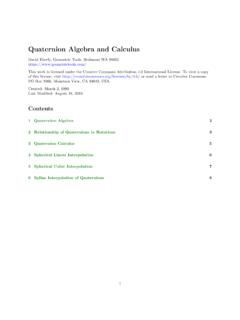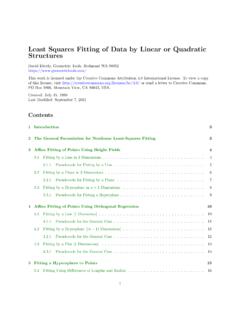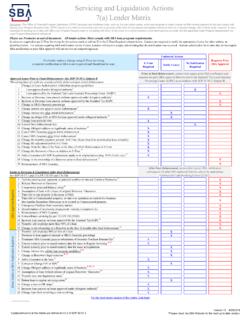Transcription of Stability Analysis for Systems of Differential Equations
1 Stability Analysis for Systems of Differential Equations David Eberly, Geometric Tools, Redmond WA 98052. This work is licensed under the Creative Commons Attribution International License. To view a copy of this license, visit or send a letter to Creative Commons, PO Box 1866, Mountain View, CA 94042, USA. Created: February 8, 2003. Last Modified: March 2, 2008. Contents 1 Introduction 2. 2 Physical Stability 2. 3 Numerical Stability 4. Stability for Single-Step Methods .. 4. Stability for Multistep Methods .. 5. Choosing a Stable Step Size .. 7. 4 The Simple Pendulum 7. Numerical Solution of the ODE .. 8. Physical Stability for the Pendulum .. 13. Numerical Stability of the ODE Solvers .. 13. 1. 1 Introduction In setting up a physical simulation involving objects, a primary step is to establish the Equations of motion for the objects. These Equations are formulated as a system of second-order ordinary Differential Equations that may be converted to a system of first-order Equations whose dependent variables are the positions and velocities of the objects.
2 Such a system is of the generic form x = f(t, x), t 0, x(0) = x0 (1). where x0 is a specified initial condition for the system. The components of x are the positions and velocities of the objects. The function f(t, x) includes the external forces and torques of the system. A computer implementation of the physical simulation amounts to selecting a numerical method to approximate the solution to the system of Differential Equations . In many cases a general-purpose solver may be used with little thought about the step size of the solver. If the simulation appears to work properly, then so be it. However, in other cases the simulation might not behave as expected. A numerical Analysis of the method is in order to determine if the numerical method is stable, and if so, to select an appropriate step size for the solver. 2 Physical Stability A solution (t) to the system (1) is said to be stable if every solution (t) of the system close to (t) at initial time t = 0 remains close for all future time.
3 In mathematical terms, reminiscient of the definition for a limit: For each choice of > 0 there is a > 0 such that | (t) (t)| < whenever | (0) (0)| < . If at least one solution (t) does not remain close, then (t) is said to be unstable. For a stable solution the - definition says that you select the maximum amount of error you can tolerate between (t) and (t). The value , which depends on your choice of , tells you how close to (0) you have to start in order to stay within that error. I refer to the Stability of the system of Differential Equations as the physical Stability of the system, emphasizing that the system of Equations is a model of the physical behavior of the objects of the simulation. In general the Stability Analysis depends greatly on the form of the function f(t, x) and may be intractable. In the case of an autonomous system where the function does not depend explicitly on t, x = f(x), t 0, x(0) = x0 (2). the Analysis is tractable.
4 An equilibrium solution of this system is a constant vector c for which f(c) = 0. That is, the constant function x(t) c is a solution to the Differential equation with initial condition x(0) = c. The system may be linearized about that constant by using Taylor's Theorem, f(x) = f(c) + Df(c)(x c) + R(x ) = Df(c)(x c) + R(x ). where Df(c) is the matrix of first-order partial derivatives of f(x) evaluated at c. If f = (f1 , f2 , .. , fn ) and x = (x1 , x2 , .. , xn ), the first-derivative matrix in general is . f1 f1 f1. x1 x 2. x n .. f2 f2 f x1 x2 xn2 .. Df(x) = .. fn fn fn x1 x2 xn 2. The remainder is R(x ) where x is some value dependent on x and c and includes the second- and higher- order terms of the original function. The last equality occurs because f(c) = 0 by definition of equilibrium solution. The linearized system is x = Df(c)(x c), but we can make the change of variables z = x c and consider instead z = Az, t 0, z(0) = 0 (3).
5 Where A = Df(c). The physical Stability of the linear system (3) is determined completely by the eigenvalues of the matrix A. which are the roots to the polynomial p( ) = det(A I) = 0 where I is the identity matrix . An eigenvector v corresponding to an eigenvalue is a nonzero vector for which Av = v. The eigenvalues can be real- or complex-valued. If = + is an eigenvalue, written as a complex number, the real part of is the real number . Stability of the Linear System 1. Every solution is stable if all the eigenvalues of A have negative real part. 2. Every solution is unstable if at least one eigenvalue of A has positive real part. 3. Suppose that the eigenvalues of A all have real parts that are zero or negative. List those eigenvalues with zero real part as j = j for 1 j `. Let the multiplicity of j be mj ;. that is, p( ) = ( j )mj q( ) where q( j ) 6= 0. Every solution is stable if A has mj linearly independent eigenvectors for each j.
6 Otherwise, every solution is unstable. The results have to do with what types of functional terms appear in the solution to the linear system. If = (real-valued), then the solution includes terms of the form e t and possibly tp e t for various positive powers p. If = + where 6= 0 (complex-valued), then the solution includes terms of the form e t sin( t), e t cos( t), and possibly tp e t sin( t) and tp e t cos( t) for various positive powers p. If < 0 for all eigenvalues, then all the functional terms approach zero in the limit as t approaches infinity. If > 0 for at least one of the eigenvalues, the corresponding functional terms are unbounded as t approaches infinity and consequently cannot stay close to the equilibrium solution zero. If = for an eigenvalue with all other eigenvalues satisfying 0, the condition that the number of linearly independent eigenvectors of is equal to the multiplicity of implies that the functional terms only include cos( t) and sin( t), both bounded for increasing time and the solutions are stable.
7 If the number of linearly independent eigenvectors is less than the multiplicity of , the functional terms include a tp cos( t) and a tp sin( ) for some p 1, in which case the solutions become unbounded as t approaches infinity, so the solutions are unstable. The physical Stability of the equilibrium solution c of the autonomous system (2) is related to that of its linearized system. Stability of the Autonomous System 1. Every solution is stable if all the eigenvalues of Df(c) have negative real part. 2. Every solution is unstable if at least one eigenvalue of Df(c) has positive real part. 3. Suppose that the eigenvalues of A all have real parts that are zero or negative with at least one eigenvalue having zero real part. Not enough information is available to conclude whether or not the equilibrium solution is stable. (More Analysis must be done.). 3. 3 Numerical Stability Physical Stability of an equilibrium solution to a system of Differential Equations addresses the behavior of solutions that start nearby the equilibrium solution.
8 However, we will solve x = f(x) using some numerical method. It is important that the approximations generated by the method are themselves close to the true solution. The concept of closeness in this context is referred to as numerical Stability . In general to obtain numerical Stability , you will need to carefully choose your step size h in the numerical solvers. The end result of our discussion will be that you can only safely do this by understanding the relationship between numerical Stability and physical Stability . Stability for Single-Step Methods Three concepts are of interest: consistency, convergence, and Stability . Local truncation error refers to the terms we discard when generating a numerical method from something such as a Taylor expansion. For example, Euler's method arises from Taylor's Theorem in representing a solution to x = f(t, x) as h2 h2. x(ti+1 ) = x(ti ) + hx (ti ) + (x)(t i ) = x(ti ) + hf(ti , x(ti )) + (x)(t i ).
9 2 2. where t i [ti , ti+1 ], but whose value is generally unknown to us. We discard the second-order term to obtain the numerical method yi+1 = yi + hf(ti , yi ). where yi is the approximation to x(ti ). The discarded term is the local truncation error for Euler's method and is of order O(h2 ). As we make h small, the local truncation error for a single iteration is small. If we can make the local truncation errors become small for k iterations, that is a good thing for our numerical method. That leads us to the definition shown below. Definition. Let i denote the local truncation error at the i-th step of the numerical method. The method is said to be consistent with the Differential equation it approximates if lim max | i | = 0. h 0 1 i k Intuitively this says that for very small step sizes, the local truncation error made at any time t is very small. According to this definition, Euler's method is consistent. In general having very small local truncation errors at any time is not enough to guarantee that yi is a good approximation to x(ti ).
10 We need a definition about closeness. Definition. A numerical method is said to be convergent with respect to the Differential equation if lim max |x(ti ) yi | = 0. h 0 1 i k Intuitively this says that for very small step sizes, the maximum error at any time t between the approximation and the true solution is very small. 4. A careful Analysis of Euler's method will show that it is convergent. Our last definition is about Stability itself. Definition. A numerical method is said to be stable if small changes in the initial data for the Differential equation produce correspondingly small changes in the subsequent approximations. In formal terms, let x0 and x1 be two initial values for the Differential equation. Let yi be the approximation to the solution x(ti ; x0 ) where the last component indicates the initial data that generated the solution. Let y i be the approximation to x(ti ; x1 ). For each > 0 there is a > 0. sufficiently small so that |yi y i | < whenever |x1 x0 | <.






